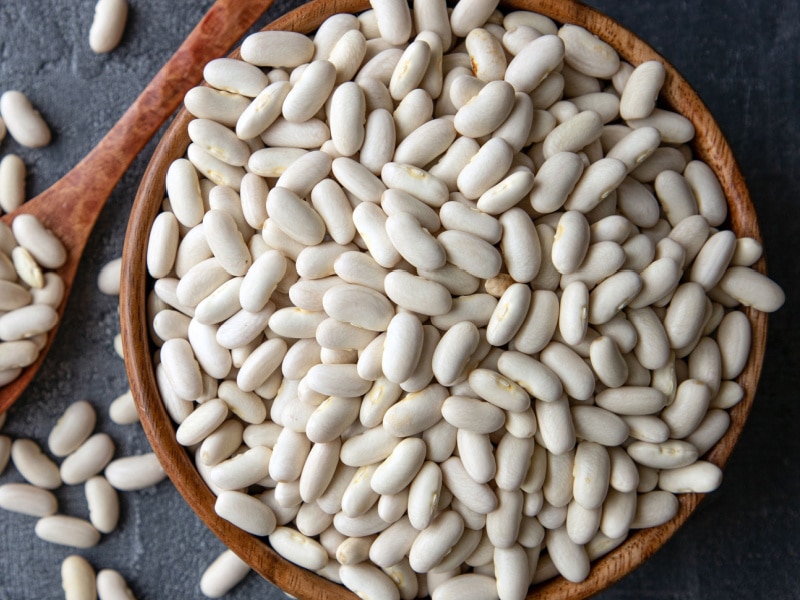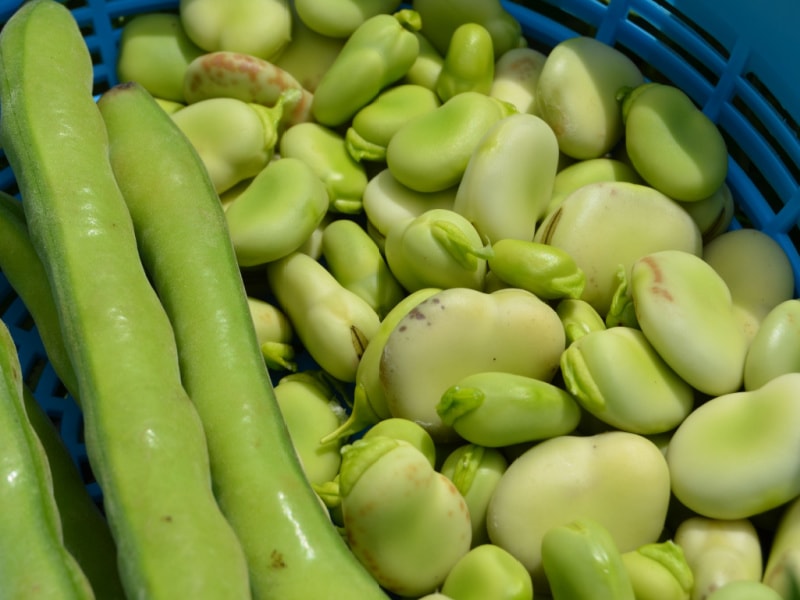How many different types of beans can you name? When you start to count them up, there are a lot!
Affordable, nutritious, and highly versatile, there are many reasons to love beans.

They’re a backbone for soups, a quick protein for salads, and a pantry staple saving you when supplies get low.
With so many varieties, it can be hard to figure out the differences between them all.
But if you want to maximize nutrition and flavors, understanding the differences is key.
So get ready to learn all about the types of beans!
1. Cannellini Beans

You might know these beans as white kidney beans. Others may know them as an Italian must.
Cannellini beans are very popular in Italian cooking. They’re also great for soups, stews, and salads.
Then there’s my favorite cannellini bean recipe, a Tuscan white bean skillet. It’s easy, robust, and super filling.
Uses aside, these large beans have a wonderful creamy texture and slightly sweet nutty flavor.
2. Black Beans

Tex-Mex wouldn’t be the same without black beans. A staple in Southwestern food, black beans are also common in South America
n cuisine.
Which shouldn’t come as a surprise because they’re endemic to the Americas.
Like white beans, they come in many varieties. Black magic, domino, and black turtle to name a few.
From cold to pureed, you can enjoy them in many ways. So if you need a little inspiration, check out these 30 black bean recipes.
Spoiler alert, they taste killer in brownies. Trust me on this one.
3. Pinto Beans

If you’ve ever had a bean and cheese burrito, you’ve had pinto beans.
They’re the most common type used for refried beans.
Actually, they are common beans too. That’s a term for legumes grown for their seeds and seed pods.
Earthy, creamy, and a little nutty, they have the perfect flavor profile for Mexican cuisine.
4. Lima Beans

Lima beans tend to get a lot of hate. But I just love them!
Native to Peru, lima beans can be green, red, or white.
They come in a wide range of cultivars like Big Mama, Christmas, and Henderson.
It’s those giant butter beans, though, that have me hooked.
They have an incredibly creamy, buttery texture and flavor.
If you haven’t already, I implore you to give them a try.
They’ll change your whole perspective on lima beans.
5. Kidney Beans

You can’t have a proper 15-bean soup without kidney beans.
Also known as red beans, kidney beans are known for their signature red color.
But they can also be white, purple, black, or spotted.
They have a meaty texture and slightly sweet flavor. They’re also super good for you.
Kidney beans are an excellent source of protein, fiber, and vitamin K.
If you fall in the “for” category in the “should beans be in chili debate,” this bean is for you.
6. Garbanzo Beans (Chickpeas)

Chickpeas should get a prize for versatility. You can use those legumes for everything!
From soups to hummus and everything in between, there’s a use for chickpeas.
Grind them into flour for high-protein pancakes or use them as an egg substitute for scrambles.
They’re a vegan diet staple and an affordable protein everybody can enjoy.
7. Adzuki Beans

Adzuki beans have a slightly sweet flavor and a big nutritional profile.
Like many other varieties, these little red beans are rich in protein and fiber.
They also host a slew of vitamins and minerals like folate and potassium.
Plus, they’re incredibly versatile. From traditional Japanese sweets to comforting curries, they’re an excellent bean to add to the rotation.
8. Great Northern Beans

The world of white beans can get pretty confusing.
So it’s no surprise that great northern beans are often mistaken for navy and cannellini beans.
The difference is these are medium in size, less dense, sweet, and slightly nutty.
Whether baked in a casserole, simmered in soup, or mashed into a dip, these beans pack a protein punch. Just one cup has 14.7 grams.
That makes them a terrific choice for a high-protein plant-based meal.
9. Lentils

Lentils are the itty-bitty superheroes of the legume world. These versatile pulses are tiny nutritional powerhouses.
They’re packed with protein, calcium, potassium, and iron. They also come in different varieties to keep things interesting.
Yellow lentils are a must for dal and red lentils make a wholesome Ethiopian stew.
Then there’s the puy variety that you can use in all kinds of lentil recipes.
10. Mung Beans

Green gram, maash, munggo, monggo, mung beans go by many different names.
Whatever you know them by, these green legumes are a popular ingredient in Asian cuisine.
They have a sort of mealy texture with a nutty and sweet flavor. Try them in curries, soups, or stews.
If you’re feeling adventurous, branch out with your mung bean recipes and make ice-cold popsicles.
They’re a high-protein dessert you can feel less guilty about eating.
11. Navy Beans

I always have a can of navy beans stashed in my pantry.
They’re a lifesaver for when the cupboards are looking a little sparse.
Soups, stews, chili, enchiladas, and skillets, there are a bunch of reasons to have them on hand.
Aside from the many uses for navy beans, they offer plenty of health benefits.
They improve digestion, aid in cognitive function, and they’re heart-healthy.
12. Soybeans

What happens when edamame matures? You get soybeans.
Soybeans are a jack-of-all-trades. As milk, tofu, or meat-free substitutes, we consume this bean in many different forms.
From white to black, soybeans come in a range of colors and varieties.
But are they good for you? There has been a lot of hype around whether or not soy is healthy.
One thing is for sure, they can be a great source of protein for those looking to cut down on meat.
13. Fava Beans

Also known as broad beans, fava beans have been around for a long time.
They’ve been a favorite of Greeks and Romans for centuries.
Nowadays, you can find them all over the globe.
Preparing fava beans is a bit of a labor of love. You have to remove the skin of each one before eating them.
The effort, though, is well worth it. Their sweet flavor and buttery texture are a true delight.
14. Peas

Peas are delightful little darlings in the green veggie world. They add a pop of sweetness to all sorts of dishes.
While they’re a great accompaniment, these legumes are awesome as the main event too.
Try pea recipes like green pea soup or smashed pea toast and you’ll see what I mean.
15. Edamame

Edamame beans are delicious green gems bundled up in a fuzzy shell.
Pop them out to savor their sweet flavor and creamy texture.
Aside from being a tasty snack, edamame is a popular ingredient in Asian cooking.
The most common way of preparing them is boiled and steamed.
You don’t need much to enjoy them either. Just a sprinkle of salt will do.
16. Gigante Beans

Gigante beans are jumbo white runner beans. They’re big meaty, creamy beans that will fill you right up.
Greek for “giant”, gigante beans are a Greek food must. Low in fat and high in fiber, they’re nutrient-dense, too.
For a taste of an authentic Greek recipe, you have got to try gigantes plaki. These Greek baked beans are exquisite.
17. Black-Eyed Peas

If you’re not familiar with black-eyed peas, then you’re not from the South.
This Southern staple is what homestyle cooking is all about.
Their signature black spot earned them the name black-eyed peas.
While that may not sound lucky, you should add them to your plate on New Year’s Day.
As a symbol of money, it’s good luck!











